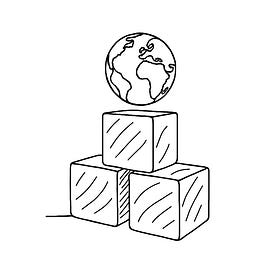Beyond Permission: Building Without Gatekeepers
Lessons from changemakers who move faster, aim higher, and act without waiting for approval.
It was recently my daughter’s 9th birthday. She’s increasingly asking questions about what she sees:
Why is a woman sleeping outside an empty café in our neighbourhood? Why doesn’t the government or a wealthy person buy her a house?
Why is plastic piling up on the beach? Why isn’t there less plastic or a plastic that dissolves?
(And the harder one) Why do adults leave problems unfixed?
My daughter naturally has fire in the belly. It’s softer than the two-year-old version in this video, which went viral in 2020 after a stranger posted it on Facebook, having been forwarded to a few friends and family for a giggle.
Turn the volume up (though maybe not at work). If the video does not load, it may be available in some jurisdictions here.
Today, my daughter’s questions and responses to the world around her carry a certain drive and impatience that many adults tend to lose. When I answer, I try to point beyond broken systems to the people, ideas, and places already doing better, rather than just focus on what’s wrong, and instead connect her to what’s possible. To foster an ambition that reaches beyond what most business and political leaders aim for today. And to develop the agency and autonomy to build better solutions without waiting for permission, vast resources, or the approval of leaders who typically won’t see a viable return on effort or investment.
Thankfully, there is a growing list of examples from around the world to inform, instruct, and invite us all - young and not-so-young - to think and act bigger.
Refusing the Status Quo
The recently released short film ‘Future Council’ captures this spirit.
The children in the film are sharp, direct, and unflinching. They sit down with executives from multinationals like Nestlé, ING, and Decathlon. They point out how these companies are harming the planet, challenge them to do better, and offer ideas that stretch beyond shareholder returns.
Photo taken at an advanced screening of Future Council, featuring a Q&A with film director Damon Gameau and Ruby Rogers, a young leader featured in the film.
Many of their ideas are clever and have a commercial edge. For example, they suggested to Decathlon that it expand the number of lines on the name tag so items of clothing could be passed down, allowing each child to display their name, and it’s an act of pride in contributing to the circular economy.
They have built a global community of children who join the Future Council. Companies are invited to appoint children as board members or strategic advisors. Effectively, they are inviting big business to leverage the perspective and ingenuity of the next generation.
The Future Council Official Trailer
Unrealistic? Or Does it Require a New Reality?
It’s hard to achieve outsized results by copying what has worked before. For market-beating, positive-sum outcomes, the advantage goes to those who learn from what’s working elsewhere and leverage it to leapfrog the status quo.
What’s one of the most underused sources of that leverage? Youth.
In most parts of the world, those under 20 have grown up in a digitally connected world. They are, in effect, born global.
This term has been used for companies designed to operate internationally from day one - businesses that skip the slow climb through local dominance before expanding into international markets.
Born global youth think the same way. They’re fluent in cross-border culture, unconcerned by the borders that slow down older generations, and are quick to adopt tools and technologies that open doors.
Celebrating Youth-Led Leadership
On the 12th August, it’s UN International Youth Day. The 2025 focus is on “Local Youth Action for the SDGs and Beyond.” More than 65% of SDG targets hinge on local action, and, while it’s been reported that SDG targets won’t be met by their 2030 target, youth have the ability to zoom-out for a global perspective, identify strategic leverage points, and zero-in for local impact.
Around the world, born-global youth are driving change and breaking down barriers, often in ways that go further, faster than traditional models:
Mobility & Road Safety: The Youth for Road Safety (YOURS) program recently selected 15 youth-led projects worldwide to make local transport safer and more sustainable, from walking campaigns in Indonesia, to community bike-share initiatives in Kenya, to road safety education for school children in Brazil.
Climate Education: In the Asia-Pacific, UNDP-trained youth volunteers are equipping thousands in rural areas with climate adaptation skills, from changing crop cycles to improving disaster readiness.
Food Security & School Gardens: In Australia, the Stephanie Alexander Kitchen Garden Foundation has established over 28,000m² of productive gardens in schools and early childhood services nationwide. Students grow, harvest, and prepare meals, sharing them with families and school communities. In low-income areas, excess produce is distributed to local residents, directly improving food access and household nutrition while building lifelong food-growing skills.
Mental Health & Peer Wellness: There are a number of initiatives globally, including Voices of Hope in New Zealand, which uses lived-experience storytelling to break stigma, encourage help-seeking, and share practical resources young people can access anytime. In Thailand, Sati App provides free, volunteer-led psychological first aid via a mobile platform, offering a safe, accessible alternative where mental health services are often unaffordable.
Community Greening and Waste Transformation: A global scan highlights youth in Egypt are converting palm waste into sustainable products and training others, tackling agricultural pollution while creating jobs. In Kenya, young innovators are turning pineapple waste into sustainable leather alternatives, reducing agricultural waste and advancing circularity. Youth groups in Nigeria collect e-waste and repurpose it into solar lamps, both mitigating hazardous waste and improving access to clean energy.
Digital Mobilisation: Young leaders are using online networks to drive campaigns for school supplies, mental health awareness, and sustainability projects that are anchored locally, amplified globally.
Learing from Young Leaders
To drive positive-sum results, these young leaders:
Identify local pain points, then draw on global perspective to find what works.
Leverage digital connectivity to crowdsource resources and amplify impact.
Pursue ground-up initiatives that can scale or be replicated across borders.
Act as bridges between community needs and the global ambition of the SDGs.
As effective drivers of positive-sum outcomes, we are watching new operating models take shape that drive outsized results. And for leaders serious about going further, faster, there’s a lot to learn and leverage here.
Three Moves to Borrow From Youth
When the pull of the status quo feels strong, borrow the frame that today’s youth offer us:
Assess: What’s stuck or stagnant? Who - or what - is saying “no” that you could design around?
Imagine: If there were no legacy systems to adhere to, few resources, and no obligation to do things “the right way,” how would you start? (It can be valuable to brainstorm this with an AI large language model.)
Identify: Who are 1–3 young people, located anywhere in the world, who could act as advisers, collaborators, or testers to help you leap ahead?
Zoom-Out to Zero-In
Youth see the bigger picture.
They play a smarter game.
And if we want to achieve outsized results and impact, so should we.
It's Impossible! Yet it happened.
Laura O’Sullivan, was a 16-year-old student from Cork in Ireland, when she developed an innovative cervical cancer detection system. This was driven by her interest in artificial intelligence and machine learning. Self-taught through online learning platforms like Coursera and edX, Laura used convolutional neural networks (CNNs) to analyze cervical smea…
Ambition: Any Age. Any Stage.
Today, ambition is unconfined by age or stage. The interconnected world has opened up new avenues to success, allowing individuals from various backgrounds to forge their paths based on talent, creativity, and determination. Examples include:
Top-Down Power vs. Bottom-Up Ambition: Who Wins?
World leaders will soon convene at the United Nations for the Summit of the Future in New York on September 22-23. Their discussions will focus on strengthening international cooperation through “Multilateral Solutions for A Better Tomorrow.” This sets the ambition to address global challenges and rectify imbalances in global governance that disproporti…






